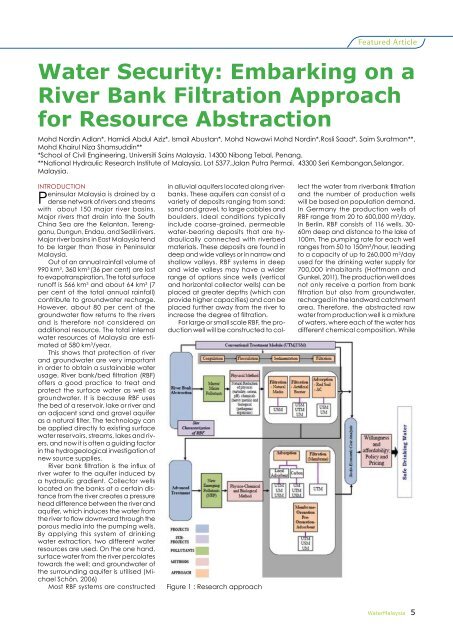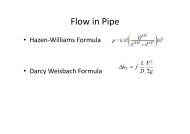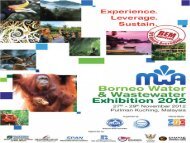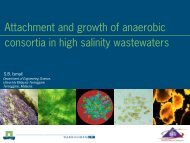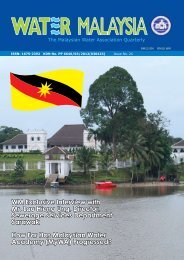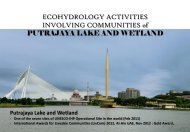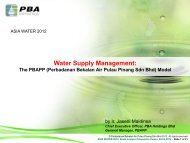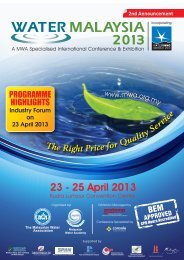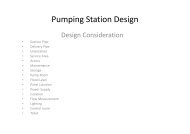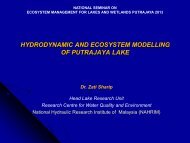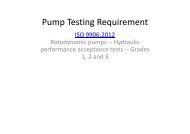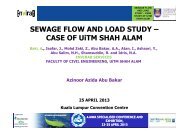Returning Malaysia's Rivers To L - Malaysian Water Association.
Returning Malaysia's Rivers To L - Malaysian Water Association.
Returning Malaysia's Rivers To L - Malaysian Water Association.
Create successful ePaper yourself
Turn your PDF publications into a flip-book with our unique Google optimized e-Paper software.
Featured Article<br />
<strong>Water</strong> Security: Embarking on a<br />
River Bank Filtration Approach<br />
for Resource Abstraction<br />
Mohd Nordin Adlan*, Hamidi Abdul Aziz*, Ismail Abustan*, Mohd Nawawi Mohd Nordin*,Rosli Saad*, Saim Suratman**,<br />
Mohd Khairul Niza Shamsuddin**<br />
*School of Civil Engineering, Universiti Sains Malaysia, 14300 Nibong Tebal, Penang.<br />
**National Hydraulic Research Institute of Malaysia, Lot 5377,Jalan Putra Permai, 43300 Seri Kembangan,Selangor,<br />
Malaysia.<br />
INTRODUCTION<br />
Peninsular Malaysia is drained by a<br />
dense network of rivers and streams<br />
with about 150 major river basins.<br />
Major rivers that drain into the South<br />
China Sea are the Kelantan, Terengganu,<br />
Dungun, Endau, and Sedili rivers.<br />
Major river basins in East Malaysia tend<br />
to be larger than those in Peninsular<br />
Malaysia.<br />
Out of an annual rainfall volume of<br />
990 km 3 , 360 km 3 (36 per cent) are lost<br />
to evapotranspiration. The total surface<br />
runoff is 566 km 3 and about 64 km 3 (7<br />
per cent of the total annual rainfall)<br />
contribute to groundwater recharge.<br />
However, about 80 per cent of the<br />
groundwater flow returns to the rivers<br />
and is therefore not considered an<br />
additional resource. The total internal<br />
water resources of Malaysia are estimated<br />
at 580 km 3 /year.<br />
This shows that protection of river<br />
and groundwater are very important<br />
in order to obtain a sustainable water<br />
usage. River bank/bed filtration (RBF)<br />
offers a good practice to treat and<br />
protect the surface water as well as<br />
groundwater. It is because RBF uses<br />
the bed of a reservoir, lake or river and<br />
an adjacent sand and gravel aquifer<br />
as a natural filter. The technology can<br />
be applied directly to existing surface<br />
water reservoirs, streams, lakes and rivers,<br />
and now it is often a guiding factor<br />
in the hydrogeological investigation of<br />
new source supplies.<br />
River bank filtration is the influx of<br />
river water to the aquifer induced by<br />
a hydraulic gradient. Collector wells<br />
located on the banks at a certain distance<br />
from the river creates a pressure<br />
head difference between the river and<br />
aquifer, which induces the water from<br />
the river to flow downward through the<br />
porous media into the pumping wells.<br />
By applying this system of drinking<br />
water extraction, two different water<br />
resources are used. On the one hand,<br />
surface water from the river percolates<br />
towards the well; and groundwater of<br />
the surrounding aquifer is utilised (Michael<br />
Schön, 2006)<br />
Most RBF systems are constructed<br />
Figure 1 : Research approach<br />
in alluvial aquifers located along riverbanks.<br />
These aquifers can consist of a<br />
variety of deposits ranging from sand:<br />
sand and gravel, to large cobbles and<br />
boulders. Ideal conditions typically<br />
include coarse-grained, permeable<br />
water-bearing deposits that are hydraulically<br />
connected with riverbed<br />
materials. These deposits are found in<br />
deep and wide valleys or in narrow and<br />
shallow valleys. RBF systems in deep<br />
and wide valleys may have a wider<br />
range of options since wells (vertical<br />
and horizontal collector wells) can be<br />
placed at greater depths (which can<br />
provide higher capacities) and can be<br />
placed further away from the river to<br />
increase the degree of filtration.<br />
For large or small scale RBF, the production<br />
well will be constructed to collect<br />
the water from riverbank filtration<br />
and the number of production wells<br />
will be based on population demand.<br />
In Germany the production wells of<br />
RBF range from 20 to 600,000 m 3 /day.<br />
In Berlin, RBF consists of 116 wells, 30-<br />
60m deep and distance to the lake of<br />
100m. The pumping rate for each well<br />
ranges from 50 to 150m 3 /hour, leading<br />
to a capacity of up to 260,000 m 3 /day<br />
used for the drinking water supply for<br />
700,000 inhabitants (Hoffmann and<br />
Gunkel, 2011). The production well does<br />
not only receive a portion from bank<br />
filtration but also from groundwater,<br />
recharged in the landward catchment<br />
area. Therefore, the abstracted raw<br />
water from production well is a mixture<br />
of waters, where each of the water has<br />
different chemical composition. While<br />
<strong>Water</strong>Malaysia 5


